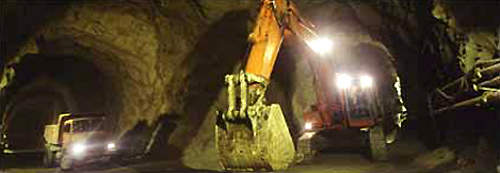The 1,020MW Tala hydroelectric project is the biggest joint project between India and Bhutan so far, generating 4865 million kWh/yr. Tala is located in Chukha Dzongkhag in western Bhutan, a small kingdom in the Himalayas. The run-of-the-river project is being managed by Tala Hydroelectric Project Authority (THPA). It is located on the Wangchu River and, at 860m, is the region’s largest high-head project.
Commissioning of the plant was planned for June 2005, but because of geological problems this was delayed until March 2007. Cost estimates were revised, too. The project was originally estimated at BTN 14 bn (the Bhutanese Ngultrum is equal to an Indian Rupee), equivalent to US$0.3bn, but this was increased in stages to around BTN 40bn. The plant was dedicated in May 2008, in front of the Prime Ministers of Bhutan and India.
The dam is 92m high and feeds a 22km-long headrace tunnel. An underground power house in Tala village has six 170MW generators. Three 440kV transmission lines stretch to the Indian border, since the power is being entirely supplied to India. Bhutan aims to export 10,000MW of power by the year 2020.
Hydroelectric project construction contracts.
The plant was supplied by Bharat Heavy Electrical Limited of India, with other Indian contractors including M/s Hindustan Construction Company, M/s Larsen and Toubro and M/S Jaiprakash Industries.
Five main contracts were awarded for construction. These covered the dam itself and first 6.4km section of the headrace tunnel (C1), a 5.13km horseshoe-shaped headrace tunnel and a 260m D-shaped adit tunnel (C2), the next 4.4km headrace tunnel section and a 960m adit tunnel (C3), the last 7.2km section of the headrace tunnel and two adits (C4), and an underground surge shaft, two pressure shafts, a tailrace tunnel and underground caverns (C5). Hindustan Construction Company Ltd were awarded C1 and C4, Larsen & Toubro was awarded C3, and Jaiprakash Industries was awarded C2 and C5.
Atlas Copco supplied the drilling and transport equipment, including five Rocket Boomer 352 two-boom face drilling rigs, five Boltec 435H rigs with pressurised cement injection, and 16 MT-420 20t dump trucks.
Drilling of the upstream and downstream tunnels both hit soft spots (moist crumbly rock which is difficult to stabilise) in 2003. Around 80% of the strata were adjudged ‘poor’ or ‘very poor’, which caused considerable tunneling delays. Blockages in inclined and vertical pressure shafts delayed completion even further. Geologists described the conditions as the worst for tunneling that had been met anywhere in the world.
Strong economic growth is reducing poverty
Bhutan has made strong economic growth and social progress over the last 20 years. Landlocked, it is surrounded by India and China and has a population of around 750,000.
Bhutan’s Poverty Reduction Strategy Paper (PRSP) was developed after extensive consultation with communities and stakeholders. The kingdom is decentralising its government and improving access to roads, electricity, telecommunications, schools and hospitals. The aim is to continue economic growth while reducing poverty, particularly in the many isolated communities in the country.
The power sector in Bhutan is essential to this effort and, even before Tala was completed, contributed about 45% of the country’s gross revenue. Tala was one of two hydroelectric projects in the Chukha region (the other was Chukha II which is immediately upstream of Tala and generates 500MW). Tala is key to Bhutan’s economy, promising to almost double the country’s per capita annual income. The Tala project was funded by the Indian Government using grants (60%) and a loan (40% at 9%).
Electricity exported to India
In 2003, the Asian Development Bank (ADB) approved a $62m loan for what was India’s first public-private partnership for power transmission. The Power Grid Corporation of India (PCI) and Tata Power formed a joint venture to transmit the power from the project to northern India. The first phase commits to 1,000MW, which will rise to 3,000MW.
Tala-Delhi Transmission is constructing more than 1,000km of 400kV power lines and 20km of 220kV lines. The power lines are being built under Build-Own-Operate-Transfer (BOOT) contracts. Tala-Delhi Transmission will operate the system for 30 years and then transfer ownership to the government-owned PCI.


